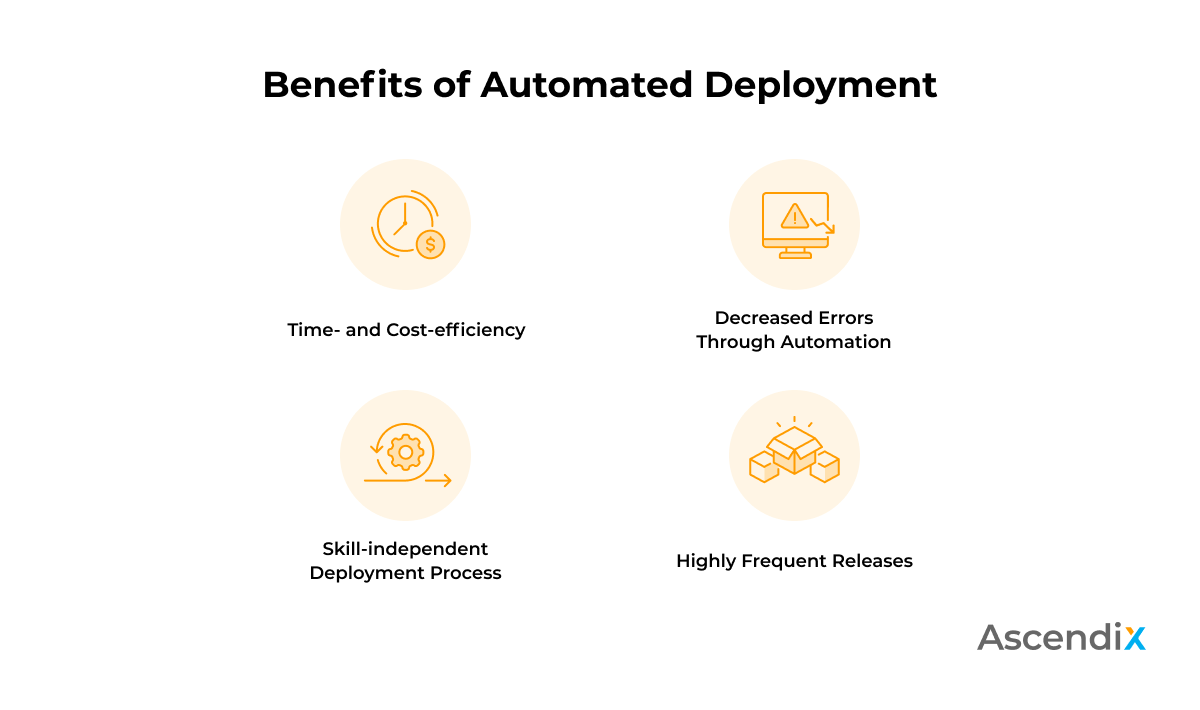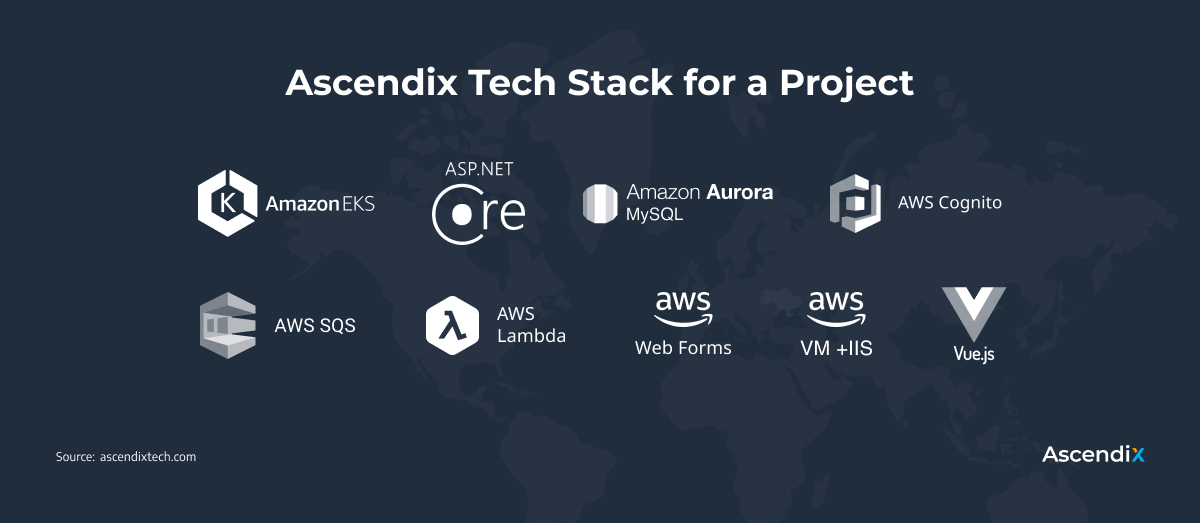Automate the Deployment Process Now
Manual deployment requires much time and money. Fill in the form and get an estimate on automation.
All entrepreneurs, startups, and SMBs want to scale their enterprises at the hands of time to serve more customers, produce more valuable products/services, and generate more profit.
Nowadays, most successful and growing companies use multiple helpful software applications for their internal or external processes, and it usually becomes a great challenge while scaling a business.
The matter is that the bigger your company becomes, the more people use the software, and the more time and funds are required for each functionality update, maintenance, and release.
And here comes deployment automation as a magic stick that allows your business to save much time, investments, and increase data transfer accuracy.
But how to automate deployment process for your company’s software in a proper way?
Today, we want to discuss the topic of automated cloud deployment, the benefits of automated deployment, and share the automated deployment case for our client that helped the company to get 245% ROI.
In general, automated deployment is the software deployment approach that allows to transform the source code into a ready-to-use software product for customers or employees automatically.
Specifically, automation deployment enables you to move the software from a testing to a production environment, thus making it accessible for end-users.
How does it work?
In simple terms, any software project development includes 3 integral parts: build, test, and deploy.
It means that software engineers first develop the required architecture and functionality you need for your system, thus creating a programming source code.
Next, QA engineers test the developed blocks of features and business logic to make sure there are no significant bugs or errors that will influence the final user experience.
In short, testers ensure the system works exactly the way you want it to function.
Ultimately, DevOps engineers deploy the developed and tested source code from a testing to a production environment, making it accessible for customers, employees, and other end-users.
In terms of development, the application deployment automation pipeline mostly includes the following:
Continuous Integration
Continuous Integration (CI) is the process of pushing the created development changes to the final environment.
Continuous Testing
Continuous Testing (CT) is about validating those code changes in the specific environment technical specialists pushed to.
Continuous Delivery
Continuous Delivery (CD) means transferring the software to the production environment and making it accessible for end-users (employees, customers).
So, automated deployment is part of any software development project success. Besides, it greatly influences the following aspects:
Let’s now discuss the key benefits of automated deployment for your business to better understand why it is crucial to know how to automate deployment process and the way it can influence the final product quality, delivery cost, and other criteria.
1. Time- and cost-efficiency
Manual deployment and delivery processes take much time as they are processes sequentially requiring technical specialists to spend much time that leads to additional expenses for your business.
Automated deployment solves this challenge and allows you to utilize automated deployment pipelines (i.e., continuous integration or CI).
What’s more, automated deployment helps you automatically handle such aspects as setting up a new environment, provision databases, and monitoring tools along with other dependencies.
In simple terms, you can save much time for your technical specialists to focus on the major tasks, which subsequently leads to great cost-efficiency.
2. Decrease errors by eliminating the human factor
Using traditional manual deployment approaches, you can encounter such human factor risks as missing important delivery steps, configuring the wrong software version, and many others.
These situations lead to extra time losses that become additional investments for your business.
The deployment automation approach allows you to minimize the potential risks as it eliminates the human factor, fully automating the deployment pipeline.
No matter how many deployment executions you will handle, automated deployment takes care of the errorless process.
3. Skill-independent deployment process
Manual application deployment automation requires high skilled DevOps engineers to set up and handle the delivery process, which complicates the process. In contrast, automated deployment allows anyone to run the deployment without any difficulties.
This means you can focus the efforts of your technical specialists on major tasks, which gives extra efficiency for the software development project.
Manual deployment requires much time and money. Fill in the form and get an estimate on automation.
4. Highly frequent releases
Automation deployment is about low overhead and high frequency, allowing your development team to test new features and deliver releases frequently.
Mostly, highly frequent releases perfectly suit the agile software development approach, which helps you to leverage all the benefits of incremental development bringing more value to customers and release new updates on demand.
Such companies as Adobe, Netflix, Valve, and others utilize deployment automation to release new updates more often, thus saving much time and funds.

Benefits of Automated Deployment
When Use Automated Deployment for Your Business
As we have mentioned earlier, manual application deployment automation takes a lot of time and technical skills, as your DevOps engineers need to set up an environment, configure relevant databases, monitoring tools, and other dependencies.
Application deployment automation helps you solve all these tasks through high automation, improve delivery accuracy, reduce human errors, save time, and funds thus giving you extra resources for the software development process.
Simply put, your business can avoid tons of repeating tasks and focus your time and investments on other major project development aspects.
Now we want to discuss the topic of automated cloud deployment and cover a detailed case study for one of our clients.
So, we got a request from the company to help them implement a more efficient security model for their existing application based on .NET Framework 4.8 that was initially run on Amazon AWS cloud platform.
After conducting the project discovery phase, we’ve built a Proof of Concept (POC) providing multiple technology solutions and answering the question ‘how to automate deployment process’.
“ That was a complete success in the customer’s opinion. For this reason, they asked us to provide them with a work breakdown structure (WBS) on organizing the microservice architecture. ”
In order to complete this task, we’ve conducted a deep analysis of the existing infrastructure that included TeamCity (a build management and continuous integration server) and Octopus (an application deployment automation server).
Based on our analysis, we suggested the client migrate its software infrastructure to Elastic Kubernetes Services (EKS) by Amazon.
One of the core challenges was to implement a microservice architecture using Linux and Windows containers because the existing customer’s application was based on .NET Framework 4.8, while our security model was based on .NET Core.
“ We had never had any experience of working with Windows containers before, but the challenge was accepted. ”
Drawing on our technical expertise in working with Windows systems and the provided documentation, we have successfully implemented the process of building containers and described our own Help templates for application deployment automation of Windows applications to Amazon EKS.
We have used the existing Continuous Integration tool called TeamCity and organized an efficient process of building containers and testing code.
Moreover, we’ve decided to utilize TeamCity as one of the automated deployment tools for delivering the project containers to Kubernetes.
“ The client was delighted with our technical decisions and technology solutions as they were planning to stop using Octopus as the main application deployment automation tool in the future. ”
Besides, we have developed a powerful monitoring system based on Prometheus and its exporters (built-in functionality) for exporting crucial metrics. Currently, we have multiple insightful dashboards for in-depth analysis of the entire software infrastructure, including:
Ascendix Tech Stack
Our technical teams utilized the following technologies for application deployment automation and other tasks:

Ascendix Tech Stack for a Project
So, let’s now briefly discuss the key challenges our client had before our successful cooperation on application deployment automation and the technology solutions we’ve delivered to their business.
Client’s initial challenges
Ascendix technology solutions
Order a complete checkup of your software project involving a deep analysis of its technical architecture, design, processes and procedures.
Ascendix has helped the company to transform its one app into an entire ecosystem that supports existing solutions and implementations of new applications (Admin App, Partner Central, User Interface, Growth Central).
Admin Application is a multitenant web application for security model management that provides a separate user interface for each organization and the functionality of user management on the organization level.
With the help of application deployment automation, Ascendix helped the client achieve approximately 245% ROI compared to the old deployment approach.
Automated cloud deployment is a perfect option for your business to reduce operational time and costs, minimize the error ratio, increase execution, and data transfer accuracy.
We hope our post will help you get an answer on how to automate deployment process through the case study for our client we’ve just shared and discussed.
What’s more, we believe that this content will help you clearly realize the benefits of automated deployment for your business system.
In case you need to automate cloud deployment, infrastructure optimization, or security model improvement, feel free to contact us and get a ball-park estimate for your project.
Ultimately, you can check our case studies to get more insights into the projects we have successfully completed to know how we solved clients’ challenges through implementing next-level software technology solutions.
Daniil specializes in content marketing and has a deep knowledge of promoting the company's products and services through high-quality content. On the Ascendix blog, Daniil shares his tricks and tips on custom software development, provides technology trends and insights, and helps you get valuable content to make your business even more successful and profitable.
Get our fresh posts and news about Ascendix Tech right to your inbox.